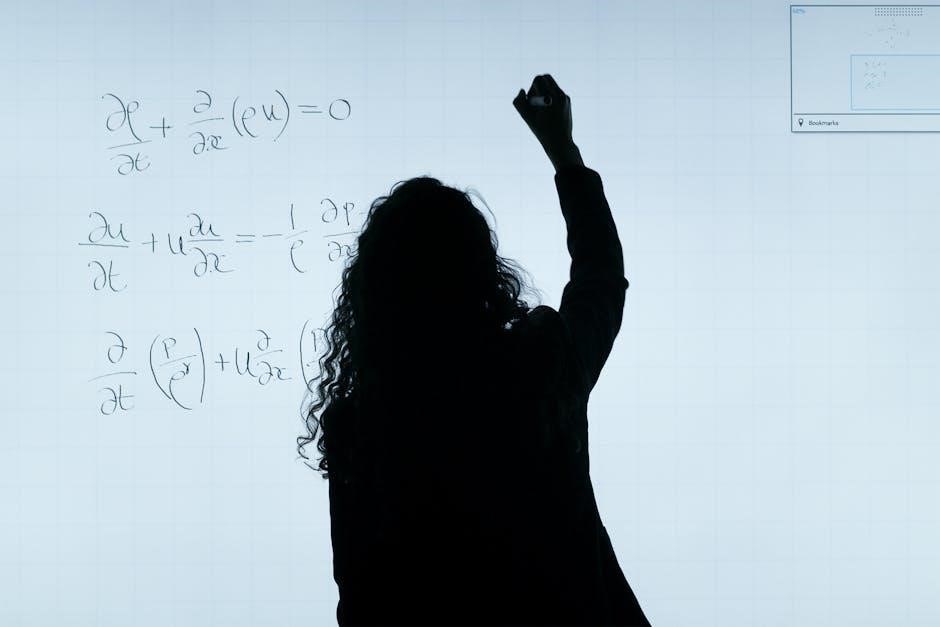Linear Algebra Done Wrong by Sergei Treil is a free, Creative Commons-licensed textbook designed as a first course in linear algebra. It humorously contrasts with Sheldon Axler’s Linear Algebra Done Right, offering a unique, accessible approach for advanced students. The book emphasizes intuitive understanding and practical applications, making it ideal for those seeking a rigorous yet approachable introduction to the subject.
Overview of the Book
Linear Algebra Done Wrong by Sergei Treil is a free, open-access textbook designed for advanced students seeking a rigorous introduction to linear algebra. Licensed under Creative Commons, it offers a unique approach that balances theoretical depth with intuitive understanding. The book serves as a first course in linear algebra, emphasizing proofs, motivations, and practical applications. It covers essential topics such as vector spaces, linear transformations, determinants, and inner product spaces, while also introducing more advanced concepts like spectral theory and tensors. Written as lecture notes for an honors course, it provides a comprehensive yet accessible foundation for students transitioning to higher-level mathematics.
Purpose and Target Audience
Linear Algebra Done Wrong serves as a rigorous introduction to linear algebra, primarily targeting advanced undergraduate students in mathematics, physics, and engineering. It is particularly suitable for those seeking a strong foundational understanding before progressing to more abstract texts like Sheldon Axler’s Linear Algebra Done Right. The book is also valuable for instructors and researchers needing a concise reference. Licensed under Creative Commons, it is freely available, making it accessible for self-study and classroom use. The text emphasizes clear proofs and practical examples, catering to students in honors courses or those preparing for advanced mathematical studies.
Relation to “Linear Algebra Done Right”
Linear Algebra Done Wrong by Sergei Treil contrasts with Sheldon Axler’s Linear Algebra Done Right in both style and approach. While Axler’s text emphasizes abstraction and theorem-proof duality, Treil’s book adopts a more computational and applied perspective. Treil acknowledges that his approach may not always align with rigorous mathematical purism, hence the title’s playful nod to Axler’s work. Both books, however, share a deep respect for the subject’s core principles. Treil’s work is often seen as a complementary resource, offering practical insights and examples that appeal to undergraduate students seeking a concrete understanding before transitioning to more abstract treatments like Axler’s.
Structure of the Book

The book is divided into clear chapters, each focusing on key concepts like vector spaces, linear transformations, and eigenvalues. It builds logically, emphasizing intuition and practical applications.

Chapter Breakdown
The book is organized into 13 chapters, each focusing on core linear algebra topics. It begins with vector spaces and bases, progressing to linear transformations, matrices, and their properties. Chapters on determinants, eigenvalues, and inner product spaces follow, with detailed explanations and examples. The structure ensures a logical flow, building from foundational concepts to more advanced ideas. Each chapter includes exercises to reinforce understanding, making it a practical resource for learners. The breakdown is designed to be comprehensive yet concise, ensuring readability and accessibility for students at various levels of mathematical maturity.
Key Topics Covered
The book covers essential topics in linear algebra, including vector spaces, linear transformations, matrices, determinants, and eigenvalues. It also delves into inner product spaces, diagonalization, and minimal polynomials. The text emphasizes the properties and applications of these concepts, providing a solid foundation for understanding linear algebra. Each topic is treated with rigor and clarity, making the material accessible to students. The inclusion of exercises and examples helps reinforce learning, while the focus on core ideas ensures a comprehensive understanding of the subject. The book is particularly strong in its treatment of linear transformations and their matrix representations.
Approach to Teaching Linear Algebra
The book adopts a unique, conversational teaching style that emphasizes understanding over rote memorization. It avoids excessive formalism, instead using intuitive explanations and examples to build conceptual clarity. Treil’s approach focuses on core ideas, such as linear transformations and vector spaces, while minimizing distractions from peripheral topics. The text is concise yet thorough, making it accessible to advanced undergraduates and graduate students. By prioritizing geometric intuition and algebraic precision, the book fosters a deep appreciation for the subject. Its approachable tone and focus on essential concepts make it an effective learning tool for students seeking a solid foundation in linear algebra.

Key Concepts in “Linear Algebra Done Wrong”
Explores foundational concepts such as vector spaces, linear transformations, determinants, eigenvalues, and inner product spaces, emphasizing their practical and theoretical significance in understanding linear algebra.
Vector Spaces and Bases
Vector Spaces and Bases are foundational concepts in Linear Algebra Done Wrong. Vector spaces are collections of vectors that can be added and scaled, while bases are minimal sets of vectors that span the space. The book emphasizes understanding finite-dimensional spaces and the role of bases in defining coordinates. It also explores the concept of dimension and its significance in structuring vector spaces. The author simplifies complex ideas, making the material accessible while maintaining mathematical rigor. The discussion of bases highlights their importance in applications, from coordinate systems to linear transformations, providing a solid groundwork for advanced topics.
Linear Transformations and Matrices
Linear Transformations and Matrices are central to understanding the book’s approach. The author explains how linear transformations can be represented as matrices, emphasizing the role of bases in this representation. The book highlights the relationship between transformations and their matrix forms, discussing topics like rank, null spaces, and invertibility. It also explores how matrices can be used to solve systems of equations and perform computations efficiently. The focus is on practical applications and intuitive explanations, making complex concepts accessible. The interplay between geometric and algebraic perspectives is a recurring theme, helping readers build a robust foundation in linear algebra.
Determinants and Trace
The book explores determinants and trace in a clear and intuitive manner. Determinants are introduced as a measure of scaling factors under linear transformations, with a focus on their geometric interpretation. The trace, defined as the sum of diagonal elements of a matrix, is linked to the sum of eigenvalues. The author emphasizes key properties, such as the trace’s linearity and invariance under similarity transformations. Practical computations and applications are highlighted, avoiding unnecessary abstraction. These concepts are presented as essential tools for understanding deeper ideas like eigenvalues and matrix decompositions, ensuring a solid foundation for further study in linear algebra.
Eigenvalues and Eigenvectors
Eigenvalues and eigenvectors are central to understanding linear transformations in the book. The author introduces these concepts through their geometric and algebraic interpretations, emphasizing their role in simplifying complex problems. Key theorems, such as the Spectral Theorem, are presented with clarity, enabling readers to grasp how eigenvectors form a basis for vector spaces. Practical examples illustrate how eigenvalues measure scaling factors and eigenvectors identify directions of change. The book builds intuition by connecting these concepts to real-world applications, ensuring a deep understanding of their significance in fields like physics and engineering. This chapter is a cornerstone for advanced topics in linear algebra.
Inner Product Spaces
Inner product spaces are thoroughly explored in the book, with a focus on their foundational role in linear algebra. The author defines inner products and their properties, such as linearity, symmetry, and positivity, while emphasizing their geometric interpretations. Orthogonality, projections, and the Pythagorean theorem are discussed in depth, providing readers with tools for decomposing spaces and solving practical problems. The book also highlights the importance of inner product spaces in applied fields like physics and engineering. Treil’s approach ensures a balance between theory and intuition, making these concepts accessible while maintaining mathematical rigor; This chapter is essential for understanding advanced linear algebra techniques.

Comparison with Other Linear Algebra Texts
Treil’s book stands out for its practical, less formal approach, contrasting with more theoretical texts like Axler’s “Linear Algebra Done Right.” It emphasizes computations and applications, making it a valuable complementary resource for students and educators seeking a different perspective on the subject.
Comparison with “Linear Algebra Done Right”
Treil’s “Linear Algebra Done Wrong” contrasts with Axler’s “Linear Algebra Done Right” by focusing on computational and applied aspects rather than rigorous theorem-proof mathematics. While Axler emphasizes abstract linear algebra, Treil prioritizes practical computations, making it a valuable resource for students in applied sciences. The book often omits formal proofs, differing from Axler’s approach, and instead provides intuitive explanations and examples. This makes “Linear Algebra Done Wrong” more accessible for those seeking a hands-on understanding, while Axler’s work remains a cornerstone for theoretical learning. Together, they complement each other, offering diverse perspectives on the subject.
Unique Features of Treil’s Approach
Treil’s “Linear Algebra Done Wrong” stands out for its emphasis on practical computations and real-world applications, making it a valuable resource for applied sciences. The book omits formal proofs, instead offering intuitive explanations and computational examples; This approach differs from more theoretically oriented texts, providing students with hands-on understanding. Treil’s focus on core concepts relevant to fields like computer science and engineering ensures a concise and focused learning experience. Additionally, the book’s conversational tone and inclusion of visual aids enhance engagement, while the availability of exercise solutions aids in self-study. This blend of practicality and accessibility makes it a unique and effective learning tool.

Selected Solutions to Exercises
Select solutions are provided to help students verify their understanding and improve problem-solving skills through detailed explanations and computational examples.
Availability of Solutions
The solutions to selected exercises in Linear Algebra Done Wrong are available online, often bundled with the free PDF download or accessible through the author’s website. While not every problem has a provided solution, key exercises are addressed to guide students through complex topics. This limited availability encourages independent problem-solving while offering assistance for critical concepts. The solutions are concise but detailed, focusing on clarity and correctness. They serve as a valuable resource for self-study and homework help, enabling learners to verify their work and deepen their understanding without overwhelming them with unnecessary information.
Role of Solutions in Learning
The solutions provided in ‘Linear Algebra Done Wrong’ play a crucial role in the learning process. They offer students the opportunity to check their work and gain insights into problem-solving methods. By reviewing the solutions, learners can identify gaps in their understanding and strengthen their grasp of key concepts. The selected solutions are designed to clarify complex topics without overwhelming students with excessive information. This approach encourages independent study and reinforces the material effectively. Overall, the solutions are an essential tool for students aiming to master linear algebra through this text.

Practical Applications of the Book
The book’s concepts are widely applicable in computer science, engineering, and data science. Its accessible approach makes linear algebra practical for real-world problem-solving in various fields.
Real-World Relevance of Concepts
The concepts in “Linear Algebra Done Wrong” are deeply relevant to modern applications in computer graphics, machine learning, and engineering. The book’s emphasis on vector spaces, linear transformations, and eigenvalues aligns with their use in data analysis, neural networks, and physics. For instance, eigenvalues are crucial in stability analysis and optimization problems, while vector spaces form the foundation of modern machine learning algorithms. The practical approach ensures readers can apply these concepts to real-world challenges, making the book a valuable resource for both students and professionals seeking to solve practical problems in science and technology.
Examples and Case Studies
“Linear Algebra Done Wrong” enriches its theoretical foundation with practical examples and case studies, making abstract concepts more tangible. For instance, the book illustrates how linear transformations are used in computer graphics to perform rotations and scaling. It also explores eigenvalues through their application in data analysis, such as principal component analysis (PCA). Case studies include solving systems of linear equations for engineering problems and applying inner product spaces to signal processing. These examples bridge theory and practice, demonstrating how linear algebra tackles real-world challenges in fields like machine learning, physics, and computer science.

Availability and Access
The book “Linear Algebra Done Wrong” is freely available as a PDF on the author’s website and various academic platforms, making it accessible to a broad audience.
Free Download Options
The book “Linear Algebra Done Wrong” by Sergei Treil is available for free download as a PDF from the author’s official website. This ensures accessibility for students, educators, and enthusiasts worldwide. The PDF version is hosted on several academic platforms, including GitHub repositories and university websites. Readers can easily find and download the book without any cost or registration requirements. This free access promotes learning and makes high-quality linear algebra education available to everyone. The PDF format allows for easy reading on various devices, making it a convenient resource for both personal study and classroom use.
Licensing and Creative Commons
“Linear Algebra Done Wrong” is released under a Creative Commons Attribution-NonCommercial-ShareAlike 4.0 International License. This licensing model allows users to freely download, share, and adapt the material under specific conditions. The CC BY-NC-SA license ensures that the original author receives proper attribution, the work is not used for commercial purposes, and any adaptations are distributed under the same license. This approach aligns with the book’s goal of making high-quality educational content accessible to everyone. The Creative Commons framework supports collaboration and education while respecting the author’s rights, making it a balanced choice for open-access resources.

Target Audience and Recommendations
Ideal for advanced students seeking deeper insights and instructors needing alternative teaching perspectives. Recommended as a supplementary resource for linear algebra courses.
For Advanced Students
“Linear Algebra Done Wrong” is particularly suited for advanced students who seek a deeper, more theoretical understanding of linear algebra. Its focus on proofs and abstract concepts makes it ideal for those familiar with basic linear algebra. The book bridges gaps often left in standard textbooks, offering a fresh perspective that aligns with advanced coursework. It is recommended for graduate students or undergraduates preparing for advanced studies. The free PDF availability ensures accessibility, making it a valuable resource for self-study or supplementary reading. The text’s mathematical rigor and concise explanations cater to students aiming to master linear algebra thoroughly.
For Instructors and Researchers
“Linear Algebra Done Wrong” serves as an excellent resource for instructors and researchers due to its unique approach and depth. The free PDF version allows instructors to easily distribute it to students or use it as supplementary material. Researchers will appreciate its concise yet rigorous treatment of linear algebra, particularly its focus on proofs and theoretical foundations. The book’s clarity and accessibility make it a valuable tool for designing advanced courses or exploring specific topics in greater depth. Its availability under a Creative Commons license also facilitates integration into academic curricula or research workflows seamlessly.

Strengths and Weaknesses
The book excels in its concise, proof-based approach, making it accessible yet rigorous. However, its brevity may limit depth for advanced topics and applications.
Strengths of the Book
“Linear Algebra Done Wrong” excels in its concise, proof-based approach, making it ideal for advanced students seeking a rigorous foundation. The book focuses on core concepts like vector spaces, linear transformations, and eigenvalues, avoiding unnecessary fluff. Sergei Treil’s clear, logical structure ensures a deep understanding of linear algebra fundamentals. Additionally, the availability of free online solutions enhances learning, allowing students to verify their work. The book’s clarity and focus make it a valuable resource for those aiming to master the subject without compromising on mathematical rigor.
Weaknesses and Limitations
Despite its strengths, “Linear Algebra Done Wrong” has some notable weaknesses. The book’s concise nature may leave beginners struggling with a lack of intuitive explanations for complex concepts. Additionally, it omits certain applied topics, focusing strictly on core theoretical aspects, which might limit its appeal for those seeking practical applications. The absence of visual aids like diagrams can also make abstract ideas harder to digest. Furthermore, the text assumes a high level of mathematical maturity, potentially excluding readers without a solid foundation in abstract mathematics. These aspects make the book less accessible to newcomers and those requiring more illustrative explanations.
“Linear Algebra Done Wrong” offers a fresh, concise perspective on core concepts, making it a valuable resource for advanced learners despite its limited accessibility for beginners.
Final Thoughts on the Book
“Linear Algebra Done Wrong” by Sergei Treil is a refreshingly practical and concise textbook that prioritizes intuition over rigorous theory, making it accessible to advanced students and professionals. Its focus on applications and problem-solving aligns well with modern learning needs, particularly in fields like computer science and engineering. While it may lack the depth of traditional linear algebra texts, its clarity and efficiency make it a valuable resource for those seeking a straightforward understanding of key concepts. The book’s availability as a free PDF further enhances its appeal, ensuring accessibility for a broad audience.
Future of Linear Algebra Education
The availability of “Linear Algebra Done Wrong” as a free PDF highlights a growing trend toward accessible, high-quality educational resources. This approach democratizes learning, enabling students worldwide to grasp complex concepts without financial barriers. The book’s practical, problem-solving focus aligns with modern demands for applied knowledge, particularly in STEM fields. As digital learning grows, such resources will likely become the norm, inspiring more authors to adopt open-access models. This shift could redefine linear algebra education, emphasizing real-world applications and fostering innovation in teaching methods. The future may see a blend of traditional rigor and practical insights, benefiting learners globally.
